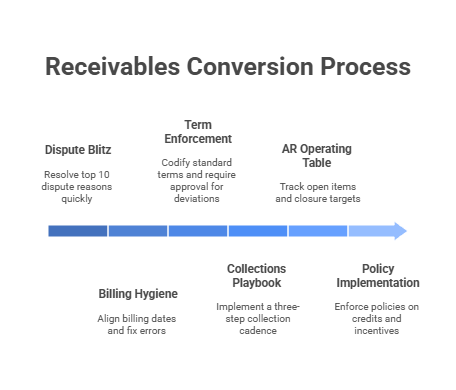Working Capital Hunts: AR, AP, and Inventory Moves That Free $10M
Oct 24, 2025
Working capital is trapped time. The objective is to convert that time back into cash without harming revenue lanes or supplier resilience. This article lays out a precise, 13-week program to release approximately $10 million in cash from accounts receivable (AR), accounts payable (AP), and inventory—all governed by a short cadence and backed by artifacts a lender or buyer can verify.
1) Objective and guardrails
-
Free cash quickly while protecting demand, quality, and supply continuity.
-
Use policy and process before price or volume concessions.
-
Create an audit trail: every move must reconcile to ledgers and bank statements.
-
Treat changes as rules with owners and expiry dates, not suggestions.
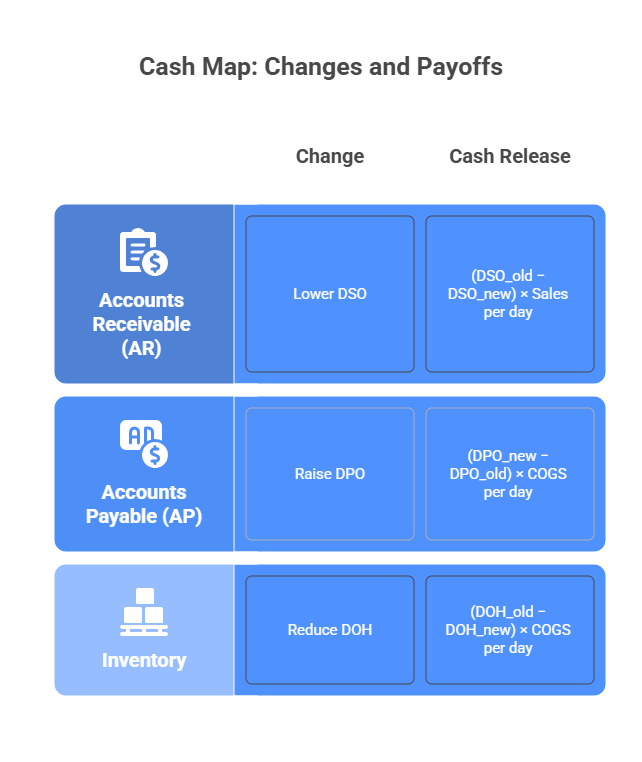
2) The cash map (what to change and how it pays)
-
AR: lower DSO by enforcing terms, closing disputes, and cleaning billing mechanics.
-
AP: raise DPO by normalizing terms, batching approvals, and phasing payments to the cash calendar.
-
Inventory: reduce days on hand (DOH) by SKU actions and supplier MoQ/lead-time alignment.
Core equations
-
Sales per day = Annual Revenue ÷ 365
-
COGS per day = Annual COGS ÷ 365
-
AR cash release = (DSO_old − DSO_new) × Sales per day
-
AP cash release = (DPO_new − DPO_old) × COGS per day
-
Inventory cash release = (DOH_old − DOH_new) × COGS per day
3) Where the first $10M usually hides (illustrative baseline)
Assume: Revenue $300M, COGS $195M, DSO 62 days, DPO 37 days, DOH 74 days.
| Lever | Baseline | Target | Driver | Cash Release |
|---|---|---|---|---|
| AR (DSO) | 62 days | 55 days | Dispute blitz + billing hygiene | ≈ $5.8M |
| AP (DPO) | 37 days | 42 days | Term normalization + approval cadence | ≈ $2.7M |
| Inventory (DOH) | 74 days | 68 days | SLOB action + demand planning | ≈ $3.2M |
| Total | ≈ $11.7M |
Notes: Sales/day ≈ $0.822M; COGS/day ≈ $0.534M. Targets are conservative and reachable in one quarter with disciplined execution.
4) AR: convert receivables to cash without discounting
Moves
-
Dispute blitz: top 10 reason codes, owners, closure target ≤ 14 days.
-
Billing hygiene: align order close dates with invoice dates; eliminate manual credit notes by fixing renewal timing and tax/shipping rules.
-
Term enforcement: codify standard terms; any deviation requires CFO approval with expiry.
-
Collections playbook: three-step cadence (reminder → escalation → credit hold) with dated templates.
AR operating table (working view)
| Reason Code | Open Items | Aging >30 | Owner | Closure Target |
|---|---|---|---|---|
| Price mismatch | 48 | 31 | AR Lead (West) | 10 days |
| Quantity/short ship | 37 | 22 | Ops Liaison | 14 days |
| PO/Receipt missing | 29 | 19 | Customer Ops | 7 days |
| Tax/freight error | 21 | 9 | Billing | 5 days |
| Admin (invoice format) | 18 | 11 | AR Specialist | 7 days |
Policies
-
No courtesy credits without root cause removal.
-
Early-pay incentives limited to SKUs with high contribution margin; impact logged.
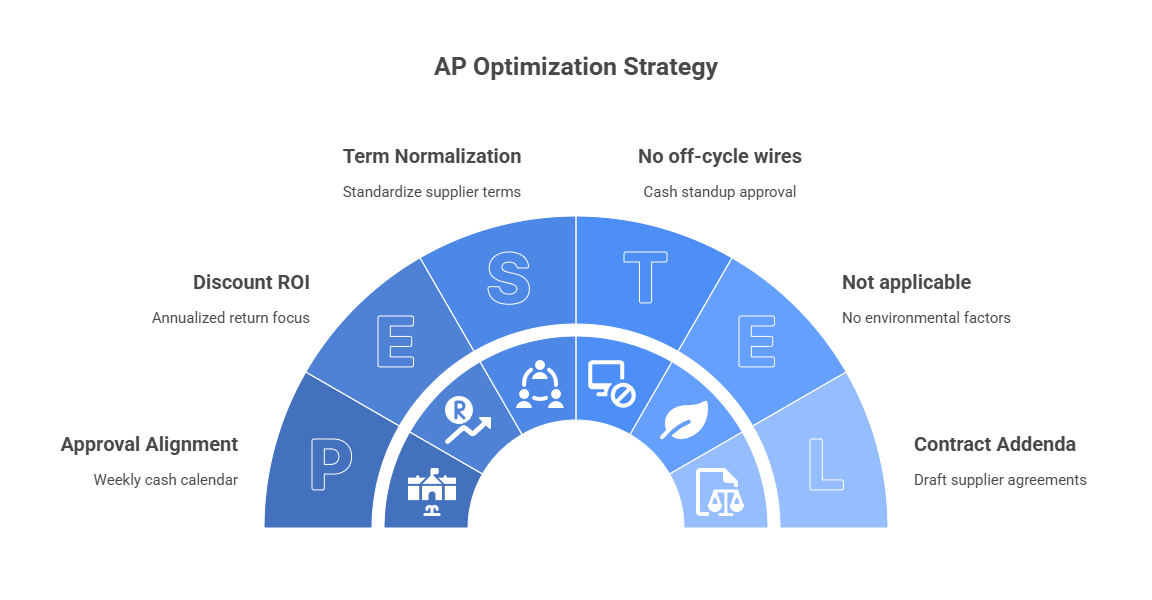
5) AP: buy time without damaging supply
Moves
-
Term normalization: standardize to “Net 45” (or closest achievable) for Tier-1/Tier-2 suppliers.
-
Approval cadence: align batch approvals with the weekly cash calendar; no Friday surprises.
-
Phased releases: split large payments across weeks to smooth headroom.
-
Discount ROI test: take discounts only where annualized return exceeds hurdle.
AP supplier map (illustrative)
| Tier | Criteria | Current Terms | Target Terms | Owner | Status |
|---|---|---|---|---|---|
| Tier 1 (Top 20 vendors) | 65% of COGS | Net 30 / 45 mix | Net 45 | Procurement | In negotiation |
| Tier 2 | 25% of COGS | Net 30 | Net 40 | AP Manager | Draft addenda |
| Tier 3/Spot | 10% of COGS | Prepay/Net 15 | Net 30 | Buyers | Case-by-case |
Policies
-
No off-cycle wires unless approved in the cash standup.
-
Capture discounts only if annualized ROI ≥ 15–18% after fees.
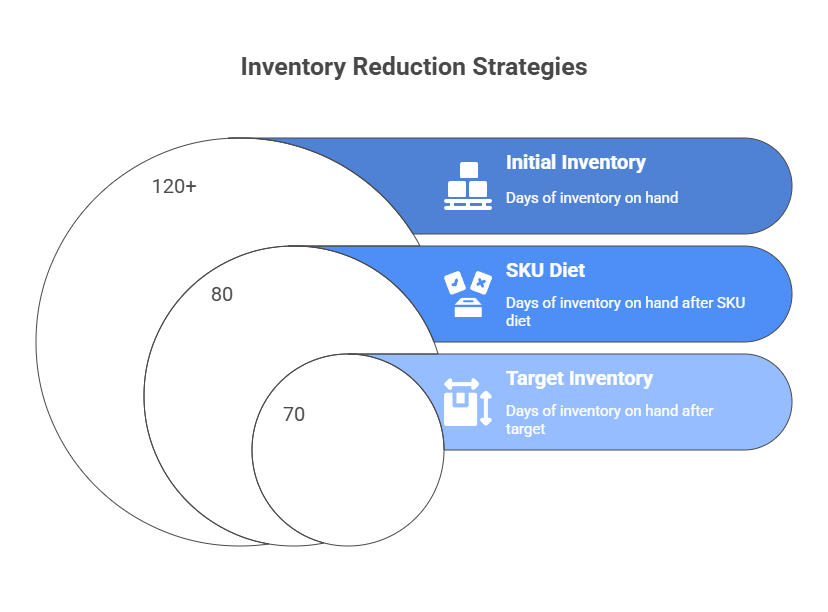
6) Inventory: shrink DOH without starving demand
Moves
-
SLOB program: identify slow/obsolete by aging and turns; action: markdown, bundle, refurb, scrap.
-
SKU diet: retire low-velocity variants that drive handling cost; enforce case packs and MoQs.
-
Planning discipline: refresh demand plan for top 50 SKUs; align safety stocks and supplier lead times.
-
Two-family turn focus: pick two large families for visible DOH improvement.
Inventory action sheet (illustrative)
| SKU Family | DOH | Target | Action | Owner | ETA | Cash Effect |
|---|---|---|---|---|---|---|
| F-Alpha | 81 | 70 | Buy block + bundle | Supply Chain | 8 weeks | $1.1M |
| F-Bravo | 76 | 66 | Markdown + VMI pilot | Category Lead | 10 weeks | $0.9M |
| Long-tail 75 SKUs | 120+ | 80 | Discontinue + scrap | Ops Dir. | 6 weeks | $0.6M |
7) 30-60-90 day plan (who does what, when)
Days 1–30: see and stabilize
-
Reconcile DSO/DPO/DOH to ledger.
-
Launch dispute blitz and publish top 10 table.
-
Lock AP approval calendar and supplier term playbook.
-
Freeze purchases on discontinued SKUs; publish SLOB list.
Days 31–60: move the numbers
-
Close ≥ 60% of open disputes; enforce standard terms on Tier-1 vendors.
-
Run two inventory pilots (bundle + markdown) and extend to families.
-
Phase large AP releases across weeks; enforce “no off-cycle without approval.”
Days 61–90: codify and scale
-
Write new policy addenda into contracts and SOPs.
-
Embed AR cadence and AP batching into the weekly cash standup.
-
Archive before/after metrics and bank-tie evidence for lenders/buyers.
8) Weekly cadence (30 minutes)
-
AR: last week collections vs forecast; top five disputes; owner dates.
-
AP: this week’s batches; large releases; discount ROI decisions.
-
Inventory: two-family DOH trend; SLOB actions completed; next actions.
-
Headroom: covenant proximity bar; decisions required.
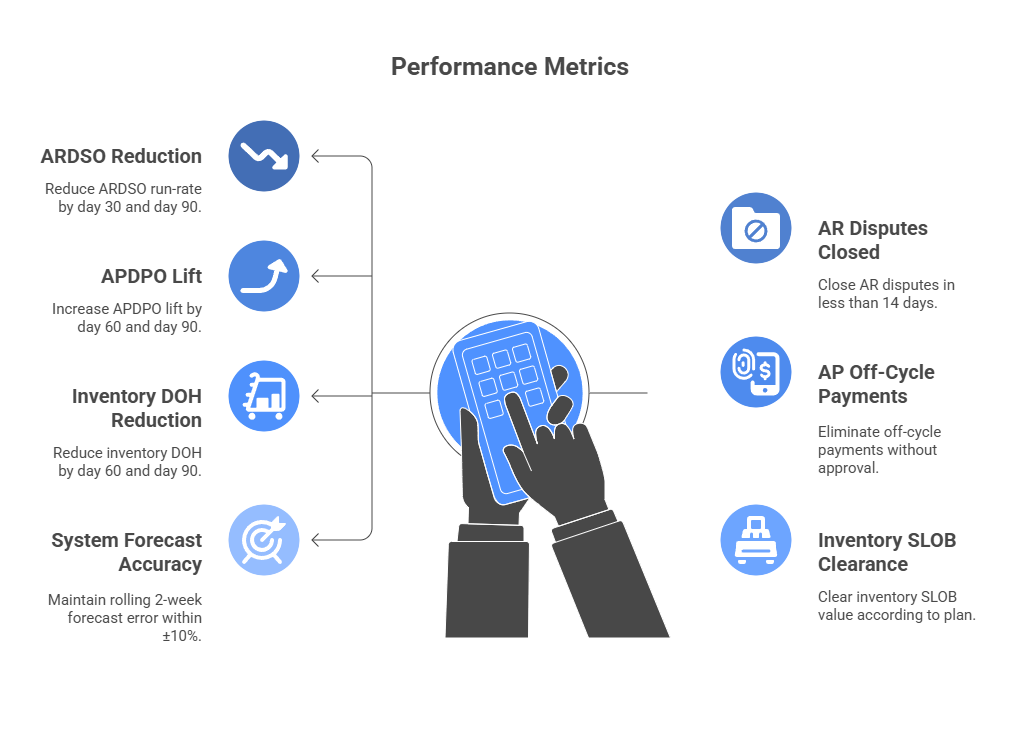
9) Metrics and thresholds
| Area | Metric | Threshold/Target |
|---|---|---|
| AR | DSO reduction run-rate | ≥ 2 days by day 30; ≥ 7 by day 90 |
| AR | % disputes closed < 14 days | ≥ 80% |
| AP | DPO lift | +3 days by day 60; +5 by day 90 |
| AP | Off-cycle payments | 0 without approval |
| Inventory | DOH reduction | −3 days by day 60; −6 by day 90 |
| Inventory | SLOB clearance value | ≥ plan; weekly cash realized |
| System | Forecast accuracy (13-week) | Rolling 2-week error ≤ ±10% |

10) Risks and mitigations
| Risk | Signal | Mitigation |
|---|---|---|
| Revenue disruption from term enforcement | churn or down-sell in top decile accounts | lighthouse exception lane; pair term changes with service improvements |
| Supplier friction | missed shipments or quality drift | negotiate staged term changes; provide forecast visibility; pay on time to new terms |
| Inventory stockouts | service level dips on A-items | protect A-class with separate buffers; focus reduction on B/C, not A |
| Policy backslide | exception creep | reason-code every exception with expiry; publish weekly exception log |
| Data drift | KPI mismatches to ledger/bank | weekly reconciliation checklist and immutable archive |
11) Controls and lender communication
-
Maintain a 13-week cash tile; reconcile weekly to bank balances.
-
Archive dispute logs, AP calendars, and SLOB actions with dates and amounts.
-
Share a one-page headroom trend and a monthly working capital bridge with lenders.
-
If needed, obtain short-term flexibility backed by the executed cash program.
12) Exit-back packaging (make the gains travel)
-
Before/after DSO, DPO, DOH with exact dates, amounts, and owners.
-
AR dispute reason-code trend and closure cycle time.
-
Supplier term matrix (old → new) with effective dates.
-
SLOB/sku-diet evidence: lists, actions, proceeds, write-offs.
-
13-week cash snapshots and bank tie-outs for the quarter.
13) 13-week cash ramp (illustrative)
| Week | Cumulative AR Release | Cumulative AP Release | Cumulative Inventory Release | Cumulative Total |
|---|---|---|---|---|
| 2 | $0.8M | $0.3M | $0.0M | $1.1M |
| 4 | $2.2M | $0.9M | $0.5M | $3.6M |
| 6 | $3.6M | $1.5M | $1.2M | $6.3M |
| 8 | $4.5M | $2.0M | $1.9M | $8.4M |
| 10 | $5.2M | $2.4M | $2.6M | $10.2M |
| 13 | $5.8M | $2.7M | $3.2M | $11.7M |
Actuals vary by mix, dispute complexity, and supplier leverage. The key is cadence and evidence.
14) One-page checklist
-
DSO/DPO/DOH reconciled to ledger
-
Dispute blitz live with owners and dates
-
AP approval calendar published and followed
-
Supplier term changes signed and staged
-
SLOB list approved; SKU diet enforced
-
Two inventory families tracked weekly
-
13-week cash tile reconciled; headroom trend published
-
Immutable monthly archive in place
VCII Note and Copyright
TVC Next treats working capital as an engineered system: policy, cadence, and clear artifacts that convert time into cash without collateral damage to revenue or supply. The objective is cash today and a verifiable story at exit.
Copyright © 2025 VCII, Meritrium Corp. All rights reserved.
We have many great affordable courses waiting for you!
Stay connected with news and updates!
Join our mailing list to receive the latest news and updates from our team.
Don't worry, your information will not be shared.
We hate SPAM. We will never sell your information, for any reason.

